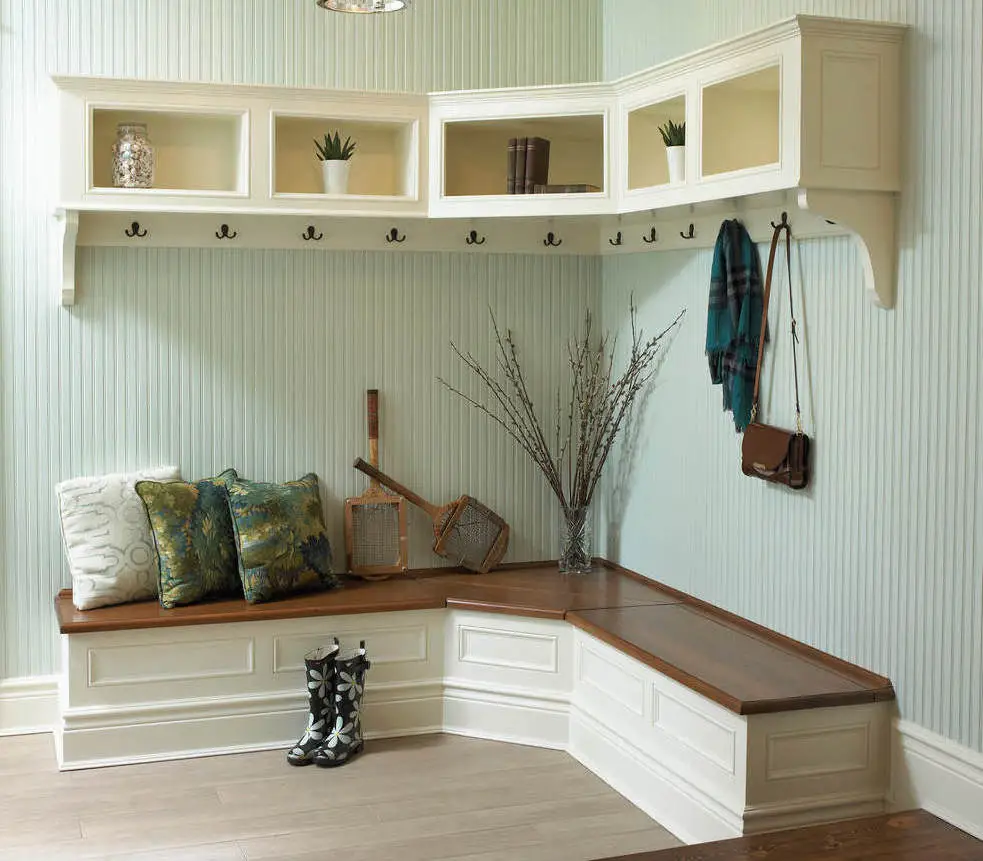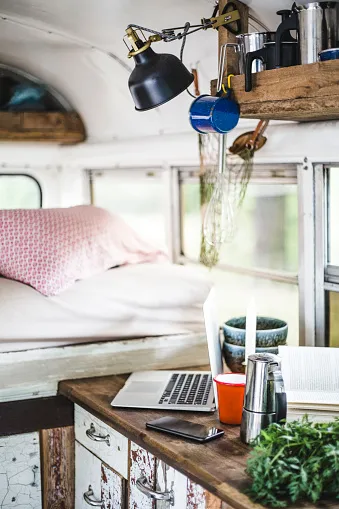Both stylish and functional, this mudroom bench is sure to be your new favorite feature of the home. With storage both overhead and below the bench seating, this space is perfect for packing away bulky seasonal items and keeping your entry way tidy.
This project can certainly be tackled with proper planning, loads of patience, and plenty of hard work, but don’t hesitate to contact a professional to help complete your dream space if it feels too large of a project to take on yourself.
Plan your bench size
Asses the size of the bench you’d like and how many cubbies (if any) you want included in the base. The goal is to have the bench serve as a custom piece for your entryway, so you want to use width dimensions that fill your space. Think through the size and dimensions of the bench before committing to materials and cuts.
Create a shopping list and a cut list based on the dimensions of the bench you are building. The example below shows a shopping list and a cut list for a lower bench that is 56” wide, 20” tall, and 17” deep, and an upper portion that is 56” wide, 76” tall (not including crown molding) and 9” deep.
Download our Shopping List and Cut List for the items you’ll need and how to cut them to a suitable size.
Bottom Bench Part 1: Building the Frame
1. Assemble the lower bench first.
For maximum stability, use a three-prong approach of wood glue, wood screws and nails using a nail gun, apply wood glue where wood meets wood and pre-drill all screw holes to avoid splitting. Make sure all your nails are going in straight. Glue, screw and nail the top horizontal board to the sides of the vertical boards. Repeat for the bottom board.
2. Attach the stabilizing bottom piece using wood glue applied in a “S” or zig-zag pattern.
This allows for air to escape, whereas a circle would trap air.
Bottom Bench Part 2: Trim Work
1. Trim out the front of the bench using 1″x2″ primed pine boards.
Attach the trim with glue and nail gun along the face of the bench. The trim will perfectly align with the double-board base and will overhang the width of the top and vertical pieces.
2. Next, trim out the sides using lattice pieces.
Glue and use nail gun with short nails to attach. If applying quarter round, take that into account when attaching lattice. Lattice may be placed above quarter round, not behind it.
Bottom Bench Part 3: Back, Prime & Paint
1. Next attach the backboard behind the bench cubbies (optional).
Glue and nail backboard to the bench frame.
2. Prime and paint the entire bench.
Bottom Bench Part 4: Bench Seat
1. Stain laminated pine and ¾” trim and coat with a polyurethane finish.
When dried, attach bench seat to the base with wood glue and nails.
2. Cut and attach stained and finished trim to the exposed edges of the stained and mounted bench seat using wood glue and a nail gun.
Bottom Bench Part 5: Build In Your Built-In
1. Move the bench to the desired location and attach it to the wall and the floor.
For an added “built-in” look, add quarter round to the base.
2. Fill in any screw/nail spots on the painted portion with wood fill and touch up with paint.
Back/Upper Portion Part 1: Building the Frame
1. Build the frame for the shelf and sides.
Use wood glue and nails to install the bottom of the shelf, then add vertical dividers for the cubbies, as done on the lower bench.
Back/Upper Portion Part 2: Trim Work
1. Stabilize the unit and create a polished look by adding the 1″x2” primed pine board over your frame, as done to the face of the lower bench frame.
Back/Upper Portion Part 3: Attach to bench
1. Build the frame for the shelf and sides.
Using L brackets, mount the frame to the wall. If one or both of the vertical sides abuts a wall, screw the frame to the wall.
Back/Upper Portion Part 4: Install the Back Wall
1. Insert smooth board to fit in the upper frame (optional).
Using L brackets, mount the frame to the wall. If one or both of the vertical sides abuts a wall, screw the frame to the wall.
2. Use 1″x2″ primed pine board for added support by adhering pieces where the inner panels of the upper frame side walls meet the bench seat.
3. Add a support for the upper storage by adding an 8 ¼” piece of MDF or plywood to the back of the unit, just under the bottom shelf of the storage cubbies.
Attach brick molding over the MDF/plywood just under the shelf. Attach cove molding just below brick molding.
4. Next, create a board and batten detail along the back wall by attaching a support piece of 1″x3″ horizontally where the bottom of the upper frame meets the bench seat.
Add four (depending on number of cubbies) vertical 1″x3″ pieces against the back wall, between the two pieces of horizontal trim. One piece will line each of the side panels, with the other two evenly distributed along the back wall, coinciding with the vertical dividers of the storage cubbies.
Back/Upper Portion Part 5: Finishing Details
1. Use 1″x2″ primed pine board for added support by adhering pieces where the inner panels of the upper frame side walls meet the bench seat.
Attach a piece of lattice board between the perimeter trim corresponding to the placement of the lower shelf of the cubbies.
2. Attach crown molding to the top of the unit.
You may use leftover scrap wood as support.
3. Apply wood fill for every screw/nail hole.
Use paintable caulk to cover all seams. Caulk can even be used where the unit meets the wall.
4. Prime and paint the back/upper portion of the unit.
5. Install hooks on the horizontal MDF trim piece for added strength and insert baskets/trays in storage cubbies.


